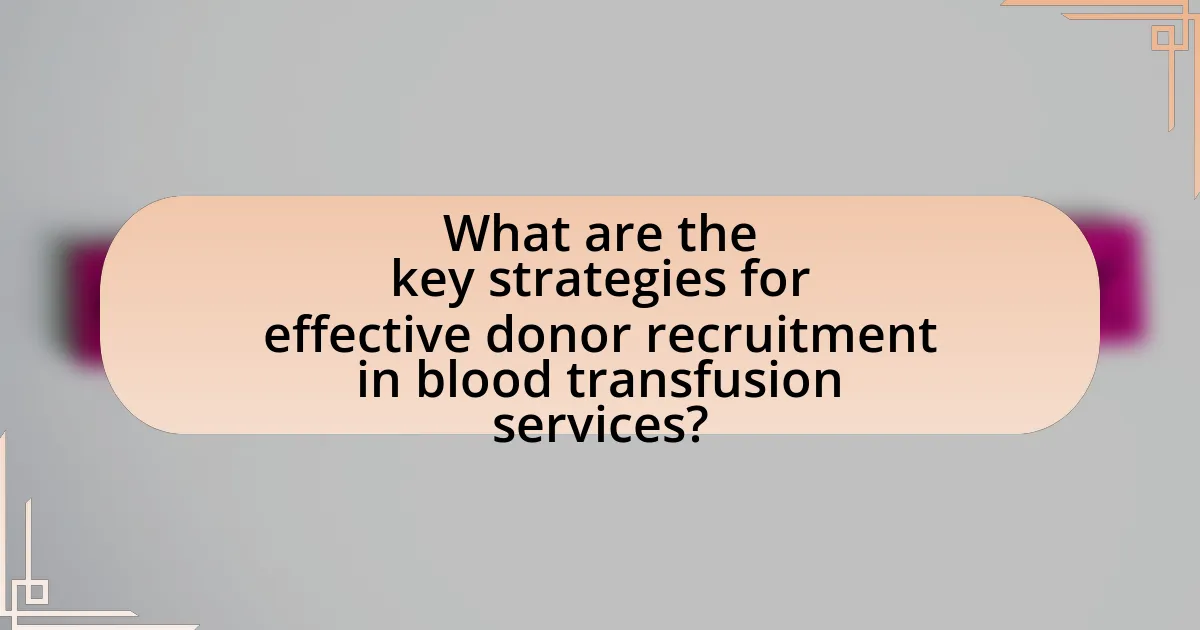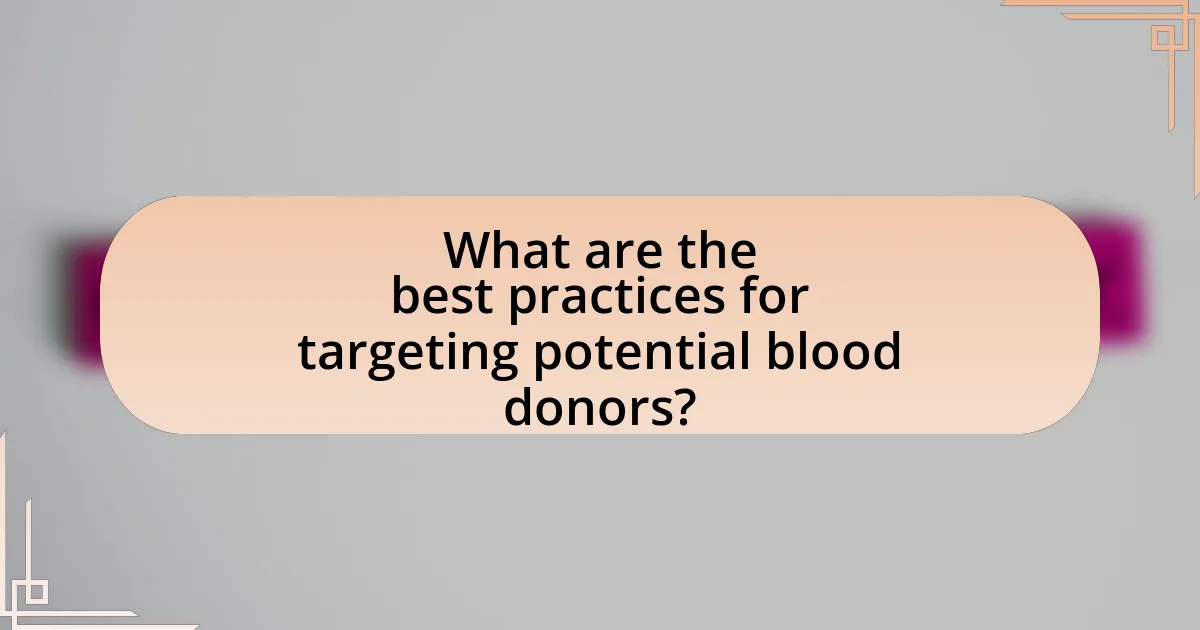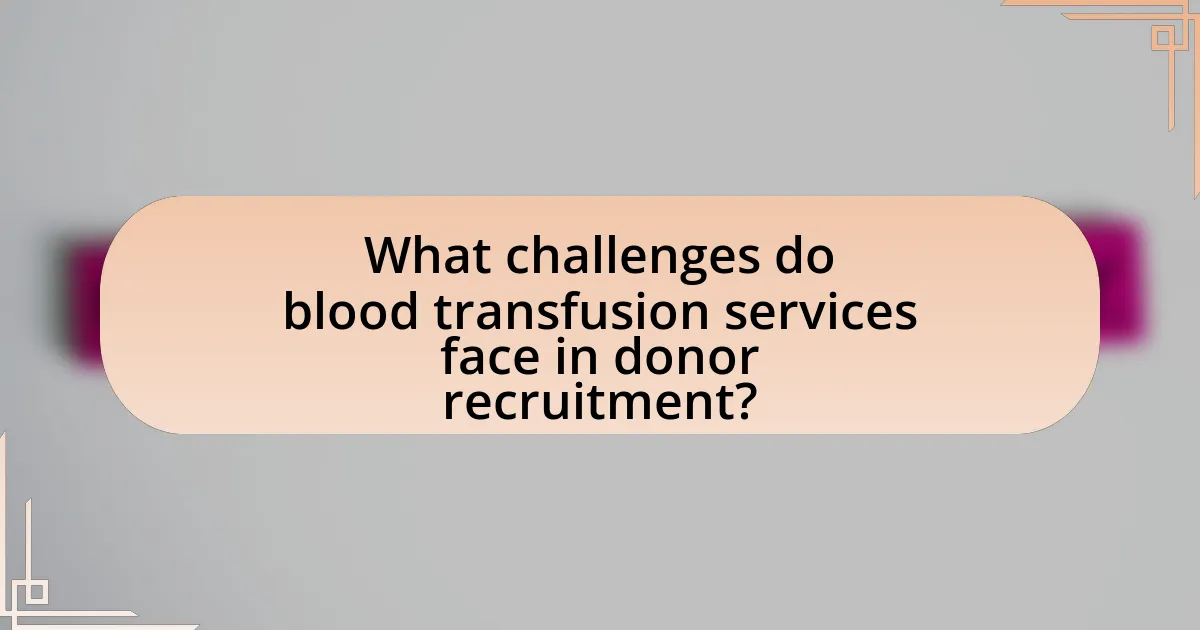The article focuses on strategies for effective donor recruitment in blood transfusion services, emphasizing targeted outreach, community engagement, and technology utilization. It explores how understanding donor motivations and psychological factors can enhance recruitment efforts, while also highlighting the importance of personal stories and testimonials in motivating potential donors. Additionally, the article discusses the role of community engagement, partnerships with local organizations, and the impact of demographic analysis on recruitment strategies. It addresses challenges faced in donor recruitment, including misconceptions and logistical barriers, and offers practical tips for improving donor retention through effective communication and follow-up strategies.
What are the key strategies for effective donor recruitment in blood transfusion services?

Key strategies for effective donor recruitment in blood transfusion services include targeted outreach, community engagement, and the use of technology. Targeted outreach involves identifying and reaching specific demographics that are more likely to donate, such as young adults or individuals with a history of donation. Community engagement fosters relationships with local organizations, schools, and businesses to promote blood donation events and raise awareness. The use of technology, such as social media campaigns and mobile apps, facilitates easier scheduling of donations and provides reminders, increasing donor participation. These strategies are supported by studies showing that personalized communication and community involvement significantly enhance donor recruitment efforts.
How can understanding donor motivations enhance recruitment efforts?
Understanding donor motivations can significantly enhance recruitment efforts by allowing organizations to tailor their messaging and outreach strategies to resonate with potential donors. When organizations identify what drives individuals to donate, such as altruism, community involvement, or personal experiences with blood donation, they can create targeted campaigns that appeal to these motivations. Research indicates that personalized communication increases donor engagement; for instance, a study published in the Journal of Blood Transfusion found that donors who received messages aligned with their motivations were 30% more likely to return for subsequent donations. By leveraging insights into donor motivations, blood transfusion services can improve their recruitment strategies, ultimately leading to higher donor retention and increased donation rates.
What psychological factors influence an individual’s decision to donate blood?
Psychological factors influencing an individual’s decision to donate blood include altruism, social norms, perceived benefits, and personal experiences. Altruism drives individuals to help others, often motivated by empathy and the desire to contribute to the community. Social norms play a significant role, as individuals may feel compelled to donate due to societal expectations or encouragement from peers and family. Perceived benefits, such as the belief that their donation can save lives, can enhance motivation. Additionally, personal experiences, such as knowing someone who has benefited from blood donation, can create a stronger inclination to donate. Research indicates that these psychological factors significantly impact donor behavior, as evidenced by studies showing that individuals who perceive a strong social support system are more likely to participate in blood donation drives.
How can personal stories and testimonials impact donor motivation?
Personal stories and testimonials significantly enhance donor motivation by creating emotional connections and illustrating the real-life impact of donations. When potential donors hear firsthand accounts of individuals whose lives have been saved or improved through blood donations, they are more likely to feel a sense of urgency and personal responsibility to contribute. Research indicates that narratives can increase empathy and engagement; for instance, a study published in the journal “Health Psychology” found that storytelling can lead to a 50% increase in willingness to donate when individuals relate to the experiences shared. This emotional resonance not only drives immediate action but also fosters long-term commitment to the cause.
What role does community engagement play in donor recruitment?
Community engagement is crucial in donor recruitment as it fosters trust and connection between blood donation organizations and potential donors. Engaging with the community through events, educational programs, and outreach initiatives increases awareness about the importance of blood donation, thereby motivating individuals to participate. Research indicates that organizations that actively involve community members in their campaigns see a higher donor retention rate, as personal connections and shared values enhance the likelihood of individuals returning to donate. For instance, a study published in the Journal of Blood Transfusion found that community-based initiatives led to a 30% increase in first-time donors, demonstrating the effectiveness of engagement strategies in building a supportive donor base.
How can partnerships with local organizations improve recruitment outcomes?
Partnerships with local organizations can significantly improve recruitment outcomes by leveraging their established community trust and networks. Local organizations often have direct access to potential donors, which enhances outreach efforts and increases donor engagement. For instance, a study published in the Journal of Blood Transfusion found that blood donation drives organized in collaboration with community groups resulted in a 30% increase in donor turnout compared to standalone events. This demonstrates that local partnerships not only facilitate better communication but also foster a sense of community involvement, leading to higher recruitment success rates.
What community events can be organized to raise awareness about blood donation?
Community events that can be organized to raise awareness about blood donation include blood drives, educational workshops, health fairs, and community challenges. Blood drives facilitate direct donation opportunities and can be hosted in collaboration with local organizations, schools, or businesses, increasing participation. Educational workshops can inform attendees about the importance of blood donation, addressing myths and misconceptions, and providing information on the donation process. Health fairs can incorporate blood donation booths alongside health screenings, promoting a holistic approach to community health. Community challenges, such as “donate a pint, save a life” campaigns, can engage local residents in friendly competition to encourage donations, often resulting in increased donor turnout. These events have been shown to effectively increase awareness and participation in blood donation initiatives.
What are the best practices for targeting potential blood donors?

The best practices for targeting potential blood donors include utilizing data-driven strategies, engaging with community outreach, and leveraging social media campaigns. Data-driven strategies involve analyzing demographics and previous donor behavior to identify and reach specific populations more effectively. Community outreach initiatives, such as organizing blood drives in collaboration with local organizations, schools, and businesses, enhance visibility and accessibility for potential donors. Social media campaigns can effectively raise awareness and encourage donations by sharing compelling stories and testimonials, which have been shown to increase donor engagement. According to a study published in the Journal of Blood Transfusion, targeted outreach efforts can increase donor turnout by up to 30%.
How can demographic analysis inform recruitment strategies?
Demographic analysis can inform recruitment strategies by identifying the specific characteristics and preferences of potential blood donors within different population segments. By examining factors such as age, gender, ethnicity, and geographic location, blood transfusion services can tailor their outreach efforts to target groups that are more likely to donate. For instance, studies have shown that younger individuals, particularly those aged 18-24, are more inclined to participate in donation drives when approached through social media campaigns. Additionally, understanding the cultural backgrounds of various communities can help organizations create culturally sensitive messaging that resonates with potential donors, thereby increasing participation rates.
What demographic factors should be considered when targeting donors?
When targeting donors, key demographic factors to consider include age, gender, income level, education, and geographic location. Age is crucial as different age groups have varying donation rates; for instance, individuals aged 18-24 are often more willing to donate. Gender influences donation patterns, with studies indicating that men are more likely to donate blood than women. Income level affects the ability to donate, as higher-income individuals may have more disposable time and resources to contribute. Education correlates with awareness and understanding of the importance of blood donation, impacting willingness to donate. Geographic location is significant because urban areas typically have higher donor rates compared to rural regions, influenced by accessibility to donation centers. These factors are supported by research from the American Red Cross, which highlights demographic trends in blood donation behaviors.
How can data analytics enhance the identification of potential donors?
Data analytics can enhance the identification of potential donors by analyzing demographic, behavioral, and historical data to target individuals more likely to donate. By leveraging data from previous donation records, organizations can identify patterns such as age, location, and donation frequency, which helps in creating targeted outreach campaigns. For instance, a study by the American Red Cross found that using predictive analytics increased donor engagement by 25%, demonstrating the effectiveness of data-driven strategies in recruitment efforts.
What communication strategies are most effective in reaching potential donors?
Effective communication strategies for reaching potential donors include personalized messaging, storytelling, and leveraging social media platforms. Personalized messaging, which addresses the individual’s interests and motivations, has been shown to increase engagement and response rates. Storytelling creates an emotional connection, making the cause relatable and compelling; research indicates that narratives can enhance donor empathy and willingness to contribute. Additionally, utilizing social media platforms allows organizations to reach a broader audience, with studies showing that campaigns on these platforms can significantly boost donor recruitment efforts. For instance, a report by the Pew Research Center highlights that 69% of adults in the U.S. use social media, making it a vital tool for outreach.
How can social media be leveraged to promote blood donation campaigns?
Social media can be leveraged to promote blood donation campaigns by creating engaging content that raises awareness and encourages participation. Platforms like Facebook, Twitter, and Instagram allow organizations to share impactful stories, statistics about blood needs, and upcoming donation events, reaching a wide audience quickly. For instance, a study by the American Red Cross found that social media campaigns increased donor turnout by 20% when they included personal testimonials and clear calls to action. Additionally, using targeted ads can help reach specific demographics, ensuring that the message resonates with potential donors.
What messaging resonates most with different donor demographics?
Messaging that resonates most with different donor demographics includes personalized appeals, emotional storytelling, and community impact narratives. For younger donors, messages highlighting social responsibility and peer involvement are effective, as they often seek to make a difference in their communities. In contrast, older donors respond well to messages emphasizing the life-saving impact of their contributions, often supported by statistics about the need for blood donations. Research indicates that targeted messaging can increase donor engagement; for instance, a study by the American Red Cross found that personalized outreach led to a 20% increase in first-time donors.
What challenges do blood transfusion services face in donor recruitment?

Blood transfusion services face significant challenges in donor recruitment, primarily due to misconceptions about blood donation, limited awareness of the need for blood, and logistical barriers. Misconceptions include fears about safety and health impacts, which can deter potential donors. Limited awareness is often a result of insufficient public education campaigns highlighting the critical need for blood donations; for instance, the World Health Organization reports that many regions experience chronic shortages of blood supplies. Logistical barriers, such as inconvenient donation locations and times, further complicate recruitment efforts, as potential donors may find it difficult to access donation sites. These challenges collectively hinder the ability of blood transfusion services to maintain an adequate and diverse donor base.
How can misconceptions about blood donation be addressed?
Misconceptions about blood donation can be addressed through targeted education and awareness campaigns. These campaigns should focus on dispelling common myths, such as the belief that blood donation is painful or that it can lead to health issues. Research indicates that educational interventions can significantly increase knowledge and positive attitudes towards blood donation, as evidenced by a study published in the Journal of Blood Transfusion, which found that informed individuals are more likely to donate. Additionally, utilizing social media platforms to share accurate information and personal donor stories can further enhance understanding and encourage participation.
What common myths deter individuals from donating blood?
Common myths that deter individuals from donating blood include the belief that donating blood is painful, that it can lead to health issues, and that certain medical conditions disqualify them from donating. Many people think that the needle insertion is extremely painful, but in reality, the discomfort is minimal and brief. Additionally, some individuals fear that donating blood can weaken their immune system or cause anemia; however, studies show that healthy individuals can safely donate blood without adverse effects on their health. Lastly, misconceptions about eligibility, such as assuming that being on medication or having a chronic illness automatically disqualifies them, are prevalent, yet many individuals with controlled conditions can still donate blood.
How can educational campaigns effectively dispel these myths?
Educational campaigns can effectively dispel myths by providing accurate information and addressing misconceptions directly. For instance, campaigns that utilize data from reputable sources, such as the World Health Organization, can clarify the safety and necessity of blood donation, countering myths that suggest otherwise. Additionally, engaging storytelling and testimonials from actual donors can humanize the process and build trust, making the information more relatable and impactful. Research indicates that targeted messaging, which focuses on specific myths prevalent in certain communities, enhances the effectiveness of these campaigns, leading to increased donor participation.
What logistical challenges impact donor recruitment efforts?
Logistical challenges that impact donor recruitment efforts include limited access to donation sites, scheduling conflicts, and inadequate transportation options for potential donors. Limited access to donation sites can deter individuals from participating, as they may not have convenient locations nearby. Scheduling conflicts arise when potential donors cannot find time to donate due to work or personal commitments, which is supported by studies indicating that flexible donation hours increase participation rates. Additionally, inadequate transportation options can prevent individuals from reaching donation centers, particularly in rural areas, where public transport may be scarce. These factors collectively hinder effective donor recruitment in blood transfusion services.
How can scheduling and location of donation drives be optimized?
Scheduling and location of donation drives can be optimized by analyzing donor demographics and historical data to identify peak times and high-traffic areas. Research indicates that drives scheduled during weekends or after work hours yield higher participation rates, as evidenced by a study from the American Red Cross, which found a 30% increase in donations when drives were held on Saturdays compared to weekdays. Additionally, placing donation sites in locations with high visibility and accessibility, such as shopping centers or community events, significantly enhances donor turnout. This approach is supported by data showing that mobile blood drives in convenient locations can increase donor participation by up to 50%.
What technology solutions can streamline the donor recruitment process?
Technology solutions that can streamline the donor recruitment process include customer relationship management (CRM) systems, mobile applications, and social media platforms. CRM systems enable organizations to manage donor information efficiently, track interactions, and analyze data to identify potential donors, thereby enhancing targeted outreach efforts. Mobile applications facilitate easy registration and appointment scheduling for donors, improving user experience and engagement. Social media platforms allow for broader outreach and engagement with potential donors through targeted campaigns and community building, which can significantly increase donor participation rates. These solutions have been shown to improve recruitment efficiency and donor retention in various studies, demonstrating their effectiveness in the field of blood transfusion services.
What are the most effective follow-up strategies for donor retention?
The most effective follow-up strategies for donor retention include personalized communication, timely thank-you messages, and regular updates on the impact of donations. Personalized communication fosters a sense of connection and appreciation, which can significantly enhance donor loyalty. Timely thank-you messages, ideally sent within 48 hours of donation, reinforce gratitude and encourage future contributions. Regular updates on how donations are utilized, such as sharing success stories or statistics about lives saved, keep donors engaged and informed about their impact, thereby increasing the likelihood of repeat donations. Research indicates that organizations employing these strategies experience higher donor retention rates, with studies showing that personalized outreach can increase donor loyalty by up to 50%.
How can thank-you messages and recognition programs encourage repeat donations?
Thank-you messages and recognition programs can significantly encourage repeat donations by fostering a sense of appreciation and belonging among donors. When donors receive personalized thank-you messages, it reinforces their positive feelings about their contribution, making them more likely to donate again. Research indicates that acknowledgment of contributions can increase donor retention rates; for instance, a study by the Association of Fundraising Professionals found that donors who received timely thank-you notes were 39% more likely to give again within the year. Recognition programs, such as donor clubs or public acknowledgments, further enhance this effect by creating a community around giving, which can lead to increased loyalty and repeated engagement with the cause.
What role does donor feedback play in improving recruitment strategies?
Donor feedback plays a crucial role in improving recruitment strategies by providing insights into donor experiences and preferences. This feedback allows organizations to identify areas for enhancement, such as communication methods, donor engagement practices, and overall satisfaction with the donation process. For instance, studies have shown that organizations that actively solicit and implement donor feedback can increase donor retention rates by up to 20%, as they tailor their strategies to meet the specific needs and expectations of their donor base.
What practical tips can enhance donor recruitment efforts in blood transfusion services?
To enhance donor recruitment efforts in blood transfusion services, organizations should implement targeted outreach campaigns that utilize social media, community events, and partnerships with local businesses. These strategies have been shown to increase awareness and engagement; for instance, a study published in the Journal of Blood Transfusion found that social media campaigns can boost donor turnout by up to 20%. Additionally, hosting blood drives in collaboration with schools and community organizations fosters a sense of community involvement and can lead to higher donor participation rates.